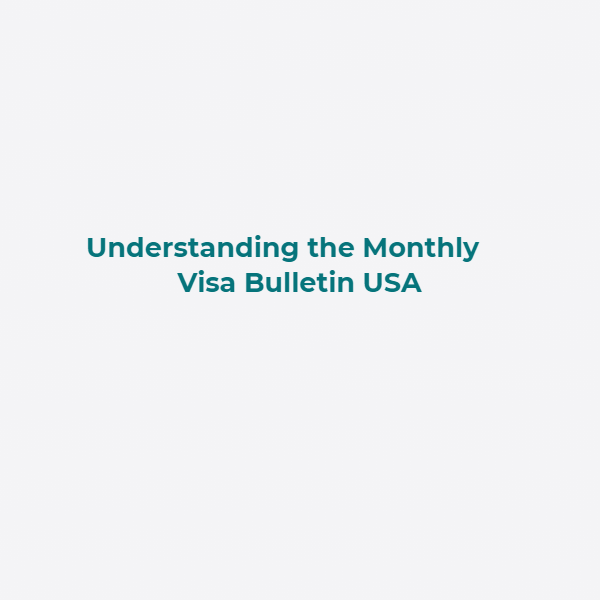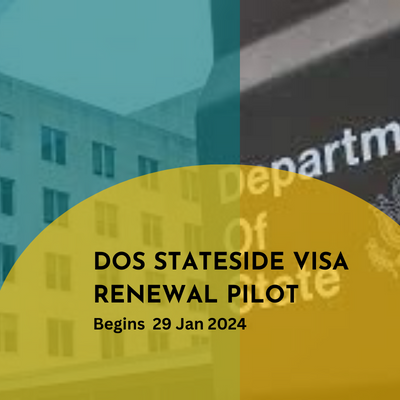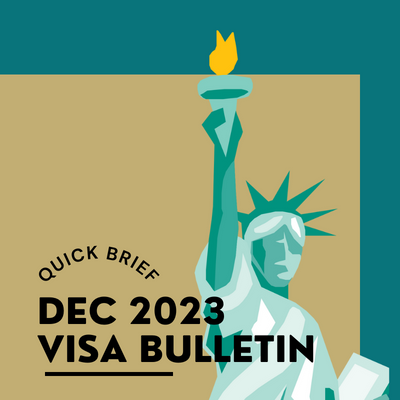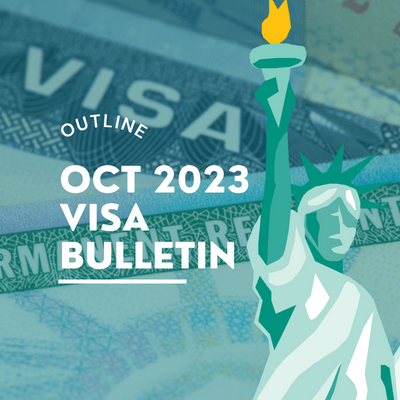The United States Department of State released the monthly visa bulletin every month. Every month, many foreign nationals in the United States eagerly await the release of the monthly visa bulletin. This publication is of importance since it tells holders of various preference visas if they are eligible for a green card. It also presents the availability of “immigrant numbers” during the month of publication. This makes the Monthly visa bulletin an important publication to many
Why A Visa Bulletin
The visa bulletin published every month by the United States Department of State shows when a foreign national’s green card application can be processed. This is dependent on the applicant’s priority date. By studying how quickly the final action date moves an applicant can estimate just when he or she will be up for a green card.
The priority date refers to the date on which the immigrant petition was filed. This is your place in line. When a final action date for a foreign national’s category and chargeability country is later than the foreign national’s priority date, then foreign nationals can move on with their immigrant visa (green) application. For this reason, it is necessary to check the visa bulletin.
Determining Priority Date :
Because there is a numerical cap on the all immigrant visas, there is always a waitlist. An applicant priority date indicates his or her place in the queue. Reviewing the priority date is quite simple. An I-797 Notice of Action is issued once the I-130 petition is approved. The I-797 Notice of Action provides information including the priority date.
For family-based preference categories, the date on which the USCIS receives the Form I-130 petition (Petition for Alien Relative) is the priority date.
For employment-based petitions requiring an approved PERM (Program Electronic Review Management) labor certification, the date when the U.S. Department of Labor receives the Application for Permanent Employment Certification (ETA Form 9089) is the priority date.
If the employment-based petition, including an EB-1 and a National Interest Waiver, does not require a PERM labor certification, the priority date is determined by when a Form I-140 (Immigrant Petition for Alien Worker) is accepted by the USCIS for processing.
If the beneficiary is a fourth preference special immigrant, including religious workers, the priority date is when the Form I-360 (Petition for Amerasian, Widow(er), or Special Immigrant) is received by the USCIS for processing.
If the beneficiary is a fifth preference investor, the priority date is when USCIS accepts Form I-526 (Immigrant Petition for Alien Entrepreneur) for processing.
If your priority date is later than the final action date published in the visa bulletin, the individual has to be patient until their priority dates are earlier or the same as the final action dates appearing on the tables released in the monthly Visa Bulletin. Of course, it is important that the foreign national’s date falls within the visa category and nationality that the foreign national falls in as well.
Although final action dates appearing on the visa bulletins released every month seem to move a month at a time, it is not always as such. The progression of the final action date is dependent on the number of applications filed at a particular time. For example, a sharp increase in the number of applications of a particular chargeability area can cause priority dates to move as slowly as a week per month. In the same vein, if there a drop in applications for a changeability area at the time of filing, priority dates corresponding to that period of time can advance as much as two months at a time.
Once that priority date is current, you can proceed with your immigrant visa (green card) application.
Date for Filing vs. Final Action Date
Up until the bulletin for October 2015, the monthly visa bulletin included just one type of cutoff day – the Priority Dates cutoffs. This date indicated when one was eligible to submit their permanent residence application. The priority date cutoff also allowed individuals know whether to expect a visa number or not.
However, starting with the October 2015 visa bulletin, there were now two set of cutoff dates. These were the Date for Filing and the Final Action Date.While the Date for Filing determined whether a final application can be submitted, the Final Action Date determined if there will be an expected visa number available.
Usually the Final Action Dates lagged behind the Dates for Filing; however, foreign nationals seeking immigrant visas could use the Dates for Filing to file for permanent residence even before it is possible for the U.S. government to approve such an application as determined by the Final Action Date.
On the Adjustment of Status Filing Charts from the Visa Bulletin, the USCIS informs foreign nationals applying for permanent residence whether to use the Dates for Filing or the Final Action Dates. For instance, for the February 2018 visa bulletin, Family-Sponsored petitions are to use Dates for Filing, while Employment-Based Preference petitions are to use Final Action Dates.
Availability of visa determines both the Dates of filing and the Final Action Dates. According to the USCIS, the agency uses numerous factors to decide if the supply for immigrant visas exceeds the demand for visa, or vice versa.
The USCIS compares the number of visas left for the remainder of a fiscal year with both the number of undecided adjustment of status applications as stated by USCIS, the number of documentarily qualified visa applications as stated by the DOS, and historical data on drop off rate of applicants for adjustment status such as abandonment, withdrawals and denials.
The Different Family-Based Categories on the State Department Visa Bulletin
It is necessary to realize that parents, children under 21 and spouses of United States citizens are not subjected to the limits that other family-based categories face. As such, visas for this category are always immediately available. These are referred to as “immediate relatives” of United States citizens.
F1 (First Preference): This is the unmarried offspring under 21 of United States citizens. Unmarred can refer to single, divorced or widowed.
F2 (Second Preference): This category is divided into 2 extra categories. This category caters to spouses and children of permanent United States residents (green card holders).
F2A: This category refers to the spouses and unmarried children under 21 of permanent U.S. residents.
F2B: This category includes unmarried children over 21 of permanent U.S. residents.
F3 (Third Preference): Married children of any age of U.S. citizens.
F4 (Fourth Preference): Siblings (brothers and sisters) of U.S. citizens fall under this category.
The Different Employment-Based Categories intestate Department Visa Bulletin
EB-1: This includes to priority workers such as multinational managers and executives, outstanding researchers and professors, and aliens of extraordinary ability. This preference category is usually current for all chargeability countries.
EB-2: This includes to professionals with advanced degrees, aliens of exceptional ability, and foreign nationals whose immigration is in the “national interest.”. This preference category is usually current for all chargeability countries apart from Mainland China and India.
EB-3: This category includes to professionals, skilled workers, and other workers. Just like the EB-2 category, this preference category is usually current for all chargeability countries apart from Mainland China and India.
EB-4: This category includes to “special immigrants”. This refers to members of the U.S. Armed Forces, juveniles, employees of international organizations, foreign medical graduates, religious workers, and U.S. government employees. This category is usually current for all chargeability countries and areas apart for El Salvador, Guatemala, and Honduras, and Mexico.
EB-5: The last category is referred to as the EB-5 immigrant investor visa, and is available to persons who invest $1,000,000 in the United States, and creates a minimum of 10 full-time jobs in the U.S. for persons other than the beneficiary’s spouse or children. This category is usually current.
Important Terms :
Before we leave, here are some important terms to keep in mind when dealing with the monthly visa bulletin.
Priority Date: This is when the U.S. Citizenship and Immigration Services (USCIS) receive a beneficiary’s I-130 petition. If a beneficiary’s priority date is after the final action date appearing on a monthly bulletin, the beneficiary can move forward with the immigrant visa application.
Current: When an entire preference category is current (C) that indicates that there is no wait time and no backlog. Additionally, a priority date becomes current if that date is earlier than the final action date in the visa bulletin. This means a green card is available to beneficiaries with that priority date. A preference category can also be U(unauthorized), which indicates numbers are not authorized for issuance for that category.
Chargeability Area: This refers to the applicant’s country of birth. This country of birth’s annual quota of immigrant visas is where the green card issued to the beneficiary will be charged.
Immediate Relatives: This refers to spouses, parents and unmarried children under 21 of United States citizens.
Cut-Off Dates: The dates that appear in the visa bulletin tables are referred to as ‘cut-off dates’. These are the Final Action Dates and the Dates for Filing.
Retrogression: This refers to when the cut-off dates move backward instead of forward. This happens when there are more applicants for an immigrant visa category than expected.
Relevant blog: January 2018 Visa Bulletin: Moderate Movement of Cutoff Dates
February 2018 Visa Bulletin: Modest Advancements
Sources:
- USCIS. (2018). When to File Your Adjustment of Status Application for Family-Sponsored or Employment-Based Preference Visas: February 2018. [online] Available at: https://www.uscis.gov/visabulletin-feb-18#When%20File [Accessed 4 Feb. 2018].






